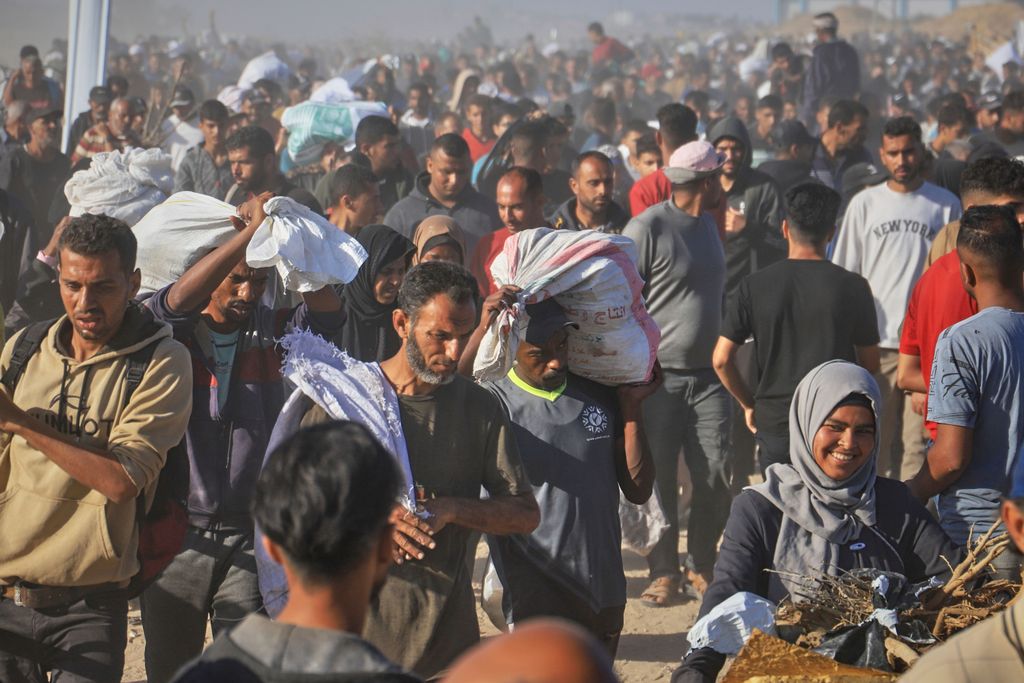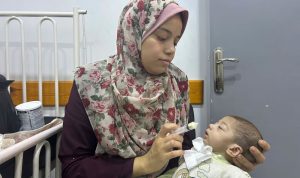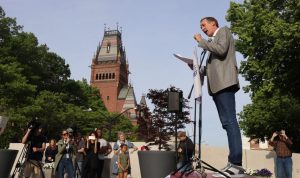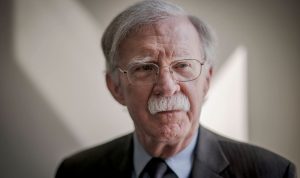Palestinians with relief supplies they received from the GHF distribution site in Rafah.
Mohammed Msallam got up early on Tuesday morning, June 3. At 2 a.m., the 37-year-old left the tent in Mawasi, near the city of Khan Younis, and made his way to Rafah, a walk of around 10 kilometers. His brother Yaser, 54, was with him, along with several nieces and nephews. Their goal: a food distribution station operated by the Gaza Humanitarian Foundation (GHF). That is what Msallam will say over the phone one day later.
Palestinians carrying boxes of relief supplies distributed by GHF.
They have hardly had any food for several weeks, says Msallam, and he doesn’t know how he should feed his three sons, aged 3, 11 and 14. He hasn’t received any supplies from aid organizations since March – supplies that he, like so many of the more than 2 million people in the Gaza Strip, is dependent on. Food has been in short supply since the beginning of the war, but in early March, the Israeli government imposed a complete blockade on Gaza, with almost nothing at all entering the region for almost three months. On May 19, Israel loosened the blockade slightly in response to massive international pressure. But Msallam has noticed very little change.
United Nations spokesman Jens Laerke recently called Gaza the "hungriest place on earth.
Mohammed Msallam with two sons in front of his tent in Khan Younis.
Which is why Msallam set off for Rafah. Despite the fact that two days earlier, dozens of people had been killed and injured, likely by Israelis soldiers, as they were trying to pick up packages of food. But Msallam decided to take the risk, nonetheless. He had no other choice, he says.
When he and his family reached the coastal road leading into the city of Rafah, the crowd grew larger, he says. He estimates that several thousand people had started making their way toward the city in the middle of the night.
All he saw around him, he says, was the rubble of destroyed buildings. He recognized nothing. Despite the fact that Rafah is actually his hometown. His home once stood not far from here, in the Tall al-Sultan district where the distribution station is now located. The GHF calls it "Safe Distribution Site 1,” or SDS 1, for short. It was scheduled to open that morning at 5 a.m., and the crowd wanted to get there on time. Ever since the organization began operations in late May, the supplies have never been sufficient for all those in line, and many people have had to return to their families with empty hands.
The distribution site SDS 1 lies inside territory occupied by Israel, an area declared as a military zone. For that reason, those looking for aid had been ordered by the army to stay on the designated route.
Msallam says they followed that route. But an estimated 800 meters before reaching the distribution site, while still on the coastal road and not far from the Al-Alam intersection, the first shots were fired, he says, machine-gun fire from the sound of it. "We threw ourselves to the ground. We couldn’t lift our heads because of the gunfire.” They continued moving, crawling on all fours.
"Around us were women, girls and older people on the desperate search for food,” says Msallam. "People were struck by bullets in the chest, the legs and even in the face.”
people with aid supplies from the controversial foundation GHF.
People with GHF aid packets near Rafah.
Suddenly, he says, his brother Yaser lifted his head. Msallam says his brother is hard of hearing, and maybe he thought the shooting had ended. "He was immediately hit in the head by a bullet.”
Msallam says he saw a tank about 500 meters away. "Shots were being fired from it.” There was also gunfire coming from drones and ships, he says. There were, he insists, no Hamas fighters in the area. "They were just normal people there. The firing clearly came from the Israeli army.” Before the war, Msallam had worked as a vendor at several shops and his brother Yaser was employed by the Palestinian Authority. Neither of them are Hamas supporters, he says.
DER SPIEGEL is unable to verify Msallam’s account, but the story he told about the events that took place early in the morning on June 3 is consistent with what additional eyewitnesses have related to other news outlets. Doctors from the aid organization Doctors Without Borders also spoke of people being injured on June 1 by shots fired by soldiers, tanks, helicopters, drones and ships.
Msallam managed to get an ambulance for his brother and left him in the care of the paramedics. None of the family members stayed with him. They continued on their way to SDS 1. "We thought he was dead and that there was nothing more we could do for him,” says Msallam. "And we badly needed food.”
Chaotic scenes near the GHF distribution site SDS 1 in Rafah.
On that same day, the International Committee of the Red Cross (ICRC) issued a press release saying that 184 people had been brought to the field hospital it operates in Rafah, including 19 people who were declared dead on arrival. Eight others died a short time later, according to the press release. "The majority of cases suffered gunshot wounds,” the ICRC noted. Along with the fact that all of the patients able to speak said that they had been on their way to the aid distribution station.
Two days earlier, on Sunday, 31 people had been killed near the Al-Alam intersection in a similar manner, as reported by the Health Ministry in Gaza, which is under the control of Hamas. The ICRC says that 21 dead people were brought to its hospital that day, along with 158 wounded, most with gunshot or shrapnel wounds. Fifty people were also wounded on Monday, with three people allegedly being killed that day on their way to receive aid.
One eyewitness told DER SPIEGEL that he had even seen seven dead bodies at the Al-Alam intersection on Monday. "I was watching as two women were shot to death,” says Hadi Abedrabu, a 39-year-old from northern Gaza who had walked more than 20 kilometers on the search for food. "I also saw five additional bodies. But the shooting was ongoing and I kept moving.” Abedrabu sent DER SPIEGEL videos that he made himself. In one of them, gunfire can be heard, likely from a machine gun. According to Abedrabu, he made the video near the intersection where the people were allegedly killed.
According to Abedrabu, this video was made near the Al-Alam roundabout, not far from the GHF distribution site.
On Sunday June 1, the Israeli army first officially denied having fired at civilians near the distribution site. After the incident on Tuesday, the military said it had fired warning shots and shot at "suspects” who had veered off the prescribed route and approached the soldiers. An investigation into the incident would be initiated, the army said.
Accounts provided by eyewitnesses to international media outlets like Associated Press and CNN also suggest that Israeli soldiers had fired on and killed those seeking aid. Further evidence has been provided by numerous videos made by people at the site, on which machine-gun fire can be heard. According to an expert interviewed by CNN, the audio is consistent with weapons used by the Israeli army.
Those injured near the GHF distribution site were brought to the Nasser Hospital.
Tom Fletcher, UN emergency relief coordinator
Palestinians with the shrouded body of a man who was killed on June 3 near a GHF distribution site.
Since then, the incidents have been called by many in Gaza and abroad an "aid massacre.” And of distribution stations as "deathtraps.”
UN High Commissioner for Human Rights Volker Türk has said that the attacks constitute "a war crime.” Tom Fletcher, the UN emergency relief coordinator, said: "No one should have to risk their life to feed their children.” Numerous politicians around the world have also expressed their horror. The Boston Consulting Group, which had been providing planning assistance to the GHF, has pulled out of the project.
With the mass killing of people seeking emergency aid in Gaza, the worst fears of humanitarian aid workers have not only come true, they have been exceeded. Prior to the killings, they had warned that the four distribution points planned by the GHF would be unable to cope with the crush of desperate people. And that the GHF did not have the logistical expertise to distribute sufficient food to the people of the Gaza Strip. By comparison, the UN had previously handed out food supplies at 400 distribution sites located throughout the Gaza Strip. Now, aid workers warned, people already weakened by hunger would be forced to walk long distances to collect food.
"This initiative seems to be a cynical ploy to feign compliance with international humanitarian law,” wrote Christopher Lockyear, the secretary general of Doctors Without Borders. "In practice, it uses aid as a tool to forcibly displace people as part of what appears to be a broader strategy to ethnically cleanse the Gaza Strip.”
For all of these reasons, the UN and other aid organizations have refused to work with the GHF.
At the end of May, the head of GHF resigned, saying the organization was not adhering to humanitarian principles.
People showing the contents of a food packet they received from the GHF: noodles, oil, rice and lentils for a few days.
The only recently established foundation claims to be neutral and independent, but its origins are dubious. From the very beginning, there were suspicions that Israel had pushed for its establishment and perhaps even initiated it itself, with support from the U.S., to create an alternative to the United Nations and private aid organizations. And all of this with the aim of controlling the distribution of aid goods.
That view seems to have been confirmed by a report from the Israeli public broadcaster KAN. According to the report, the government of Israeli Prime Minister Benjamin Netanyahu made the equivalent of 175 million euros available to fund the GHF – and sought to obscure the financing. Prior to the report, GHF had announced that it had received $100 million from an anonymous state donor. That donor, it is suspected, was the Israeli government.
If the report is true, the GHF is not an independent foundation but a de facto subsidiary of the Israeli army.
For quite some time, right-wing extremist members of the Israeli government have been demanding that the Israeli army take direct control of aid distribution. They see it as the first step toward the goal of a long-term occupation of the Gaza Strip – because in order to distribute aid, the army must develop infrastructure and an administration, which could function as the nucleus of a military authority.
Army leaders and Netanyahu, however, want to avoid the direct involvement of the army in aid distribution. The military is concerned that doing so could require thousands of soldiers and put their lives at risk. Netanyahu, for his part, is likely primarily worried about the immense political and financial costs of such a move. Using the GHF as a veiled subcontractor seemed to be the preferable model, giving Israel control over aid deliveries. At the same time, the government can defend itself against accusations that it is starving the population of Gaza – allegations that also play a central role in proceedings before international courts in The Hague.
Christopher Lockyear, Doctors Without Borders general secretary
Israeli officials have publicly justified their support of GHF by saying it prevents Hamas from diverting aid supplies and earning money by then selling them. No proof has been provided, however, that Hamas has confiscated significant quantities of aid goods. Representatives from the UN and from aid organizations have denied the claims.
Since January, Israel has prohibited operations by the UNRWA, the UN body designated to support Palestinian refugees, inside of Israel, which also makes its work inside the Gaza Strip practically impossible. Israel accuses the organization of having been infiltrated by Hamas. An independent evaluation did not confirm the allegations.
GHF claimed that it would precisely monitor who would receive food aid. There was talk of notifications by text message and facial recognition technology. Witnesses on site, however, have reported chaos at distribution points, saying there were no controls and that people in the crowd just grab all they can carry. There have also been numerous reports of looters robbing people of their aid packages as they sought to return to their families.
The crowd at the GHF distribution site in Rafah.
Instead of more controls, there are now fewer. People who want to pick up food are risking their lives. And still, most people end up with nothing. Furthermore, there is hardly anything for sale in Gaza any longer – and what is available is going for astronomical prices. In many places, flour costs more than 10 euros per kilogram.
After Mohammed Msallam turned over his brother, who he thought was dead, to the paramedics, he continued onward to the aid distribution site, he says. But he arrived too late. All of the boxes were gone. On that day, the GHF distributed just over 20,000 aid packages. Msallam says he was able to collect a few cans and a couple packets of lentils and rice that had fallen to the ground in the chaos.
On the way back to Khan Youris, he says, he was then threatened by looters armed with knives and clubs who were trying to take what little he had managed to collect. But because he knew one of the men, Msallam says, he was allowed to continue on his way.
He estimates that the food he collected will keep him and his family going for about four days. But he doesn’t know what he is going to do after that. He no longer wants to go to a distribution site. "I don’t want to lose my life just for a bit of food,” he says.
After delivering the food to his family, he went to the ICRC field hospital to collect his brother’s body. It was only then that he learned that Yaser was still alive.
Mohammed Msallam with his wounded brother Yaser in the hospital. Yaser survived after being struck by a bullet in the head.
On the day after the bloody Tuesday, the distribution centers were closed for "renovations, organization and efficiency improvements,” according to a GHF announcement.
But even if GHF were able to ensure the efficient distribution of aid goods, it would likely only be able to feed a tiny portion of the population. "It won’t even be close to enough,” says one diplomat. Particularly because many of the displaced in Gaza have no pots, much less firewood or gas, to cook noodles or rice.
A soup kitchen in Khan Youris: Only about 250,000 meals per day are now being distributed in the Gaza Strip.
Until just a few weeks ago, the people of Gaza were able to receive free hot meals once a day at community kitchens. At the end of April, the UN-backed kitchens were distributing a million meals per day. Now, it is just 260,000. Most kitchens have had to suspend operations for a lack of supplies. Bakeries have also had to close after running out of flour.
Furthermore, the GHF is only distributing food. But the people of Gaza also need medicine, baby food, soap, diapers, tents and fuel. All of that must still be brought into the Gaza Strip by the United Nations. But access to these humanitarian supplies has also been made more difficult.
Since Israel ended the complete blockade of Gaza on May 19, just 1,100 truckloads have been allowed to pass through the only open border crossing at Kerem Shalom (as of June 5). And only 400 of those truckloads could be picked up on the other side by the UN and other humanitarian organizations. The UN has placed blame for the situation primarily on the Israeli army.
Because in order to get to Kerem Shalom, the trucks must pass through military security zones. "That is an extremely difficult, dangerous and sometimes time-consuming process,” said Olga Cherevko, a spokeswoman for the UN Office for the Coordination of Humanitarian Affairs (OCHA), told DER SPIEGEL in late May. They require army authorization for each trip, and such authorization is often not granted. Even in situations where permission is granted, drivers often must wait for hours – before then spending several hours to navigate the completely destroyed roads to cover distances that once only took 30 minutes.
Humanitarian goods being unloaded on the Israeli side of the Kerem Shalom checkpoint.
And when the fully loaded trucks finally approach the warehouses, they are almost always looted by desperate crowds. Only a few trucks are currently reaching the warehouses. The UN refers to the phenomenon as "self-distribution.” Which merely means that people take all that they can carry. At best, they use it to feed their families. But the most vulnerable are left empty-handed.
The looting will only end when the situation is no longer as catastrophic as it currently is, say UN officials. But for that to happen, Gaza must be flooded with huge quantities of aid. And that doesn’t appear to be in the offing.
Bezalel Smotrich, Israeli finance minister
But it’s not just the desperate who are plundering UN convoys. Criminal gangs are also operating in the Gaza Strip. On June 4, a driver was even shot to death. For quite some time, aid organizations and the UN have pinned responsibility on Yasser Abu Shabab, the leader of a criminal militia. His people, it is said, are "paid employees” of Israel and, now, of the GHF. The fact that they operate in areas under control of the Israeli army seems to substantiate such claims.
Last Thursday, this suspicion was confirmed. Former Israeli Defense Minister Avigdor Liberman publicly claimed that Netanyahu had provided his approval to supplying Abu Shabab and his people with weapons. The prime minister later confirmed Liberman’s comments. "What’s wrong with this?” Netanyahu said in a brief video statement. The government is apparently hoping that the militia will fight against Hamas.
The Israeli government seems not to care that Abu Shabab and his militia is plundering aid supplies. Or is that perhaps a desired result?
Right-wing extremist Bezalel Smotrich has been propagating the expulsion of the Palestinians from Gaza for months and was one of the most vocal supporters of the total blockade. If he had his way, not even water would be provided to the Palestinians in Gaza until the last hostage was freed, he said in mid-May. But that’s not possible, he said, because "the world” would "force an immediate halt to our war.” For tactical reasons, only the "bare minimum” should be allowed into Gaza. "No more than a piece of pita bread and a plate of food from public kitchens.”
With reporting by Almut Cieschinger and Marvin Milatz










